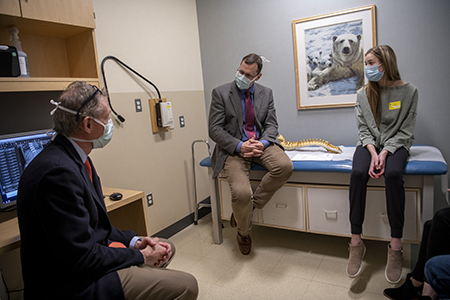Patient EducationFeb | 22 | 2021
Tethering Surgery for Scoliosis: Surgery and Recovery

How long does tethering take at the hospital?
This depends on which type of tethering your child needs. Ask the care team how long your child’s surgery may be.
- Tether of one curve: 2-3 hours
- Tether of two curves: 4-6 hours
- Hybrid procedure with fusion of one curve and tether of a second curve: 4-6 hours
How long does it take for a child to recover from a tether surgery?
Most children stay in the hospital for 3 nights. Children can return to school about 2-3 weeks after surgery. They can usually return to all other activities about 3 months after surgery.
What happens if the tether breaks or becomes worn out?
Tether rupture or breakage has not been a common problem, but can occur on occasion. Tether rupture, if it does happen, usually does not cause pain or other symptoms but it can mildly change the scoliosis correction. This change is most often not big enough for your child or family to notice, but doctors can see it on x-ray. Most tether ruptures occur at one spot along the scoliosis. Therefore, most of the tether and the scoliosis correction remain intact. The most common case of tether rupture doctors may see is in a child with no specific complaints and no activity restrictions but has a slight change in scoliosis correction noted on a routine follow-up x-ray 2-5 years after surgery. Importantly, additional surgery is rarely required.

Who is on my child’s care team?
MGfC takes a team-based approach to care to ensure your child receives the most compassionate and comprehensive (well-rounded and thorough) care possible. The following providers will be on your child’s care team throughout their care at MGfC:
- Two pediatric spine and scoliosis surgeons
- One pediatric general surgeon
- Multiple pediatric anesthesiologists
- Multiple nurses and nurse practitioners
- Child Life Specialist
Why come to MGfC for tethering?
There are many reasons to come to MGfC if your child needs tethering:
- A team-based, family-centered approach to care. There are several people working together on your child’s care team, from doctors and surgeons to nurses and Child Life Specialists. As the family member, you are also an important member of the care team because you know your child best.
- Treatment is personalized to meet your child’s unique medical, social, emotional and mental health needs. A multidisciplinary team also ensures your child receives the best care possible.
- Members of the care team are experts in caring for children with scoliosis and have a greater combined experience with anterior vertebral tethering than any other center in the world. The surgical team includes John T. Braun, MD, and Brian E. Grottkau, MD, both pediatric spine and scoliosis surgeons who pioneered and developed this new treatment, and David Lawlor, MD, a pediatric surgeon with expertise in minimally invasive surgery for scoliosis and other conditions.
Rev. 2/2021. Mass General for Children and Massachusetts General Hospital do not endorse any of the brands listed on this handout. This handout is intended to provide health information so that you can be better informed. It is not a substitute for medical advice and should not be used to treatment of any medical conditions.
-
![]()
- Orthopaedic Spine Surgeon
- Pediatric Spine & Scoliosis Surgeon
-
![]()
- Pediatric Surgery
- Department of Surgery
Related Pages
Type
Patient Resources
Patient resources for Pediatric Orthopaedics
Meg's story: Tethering surgery helps dancer with scoliosis stand tall again
Without critical surgery to correct her scoliosis, Meg's performance career almost ended early. Three months after surgery, Meg returned to the stage.
Appointments and Referrals
Request an appointment or second opinion, refer a patient, find a doctor or view test results with MGfC's secure online services.



